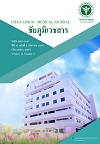Factors related to amputation of diabetic foot in Nongbuadaeng hospital, Chaiyaphum Province
ปัจจัยที่มีความสัมพันธ์กับการตัดนิ้วเท้าหรือตัดขาของผู้ป่วยแผลเบาหวานที่เท้าในโรงพยาบาลหนองบัวแดง จังหวัดชัยภูมิ
บทคัดย่อ
Purpose: A Diabetic foot is the most common cause of non-traumatic lower extremity amputation (LEA). The study concern to assess the risk factors of amputation in patients with diabetic foot ulcers (DFU)
Materials and Methods: The retrospective study was conducted on 177 patients with DFUs from October 2015 to September 2019. Their demographic characteristics, disease history, laboratory data, foot deformities, Wagner classification, osteomyelitis and ulcer sizes were considered as variables to predict outcome. A chi-square test and multivariate logistic regression analysis were performed to test the relationship of the data gathered. Additionally, the subjects were divided into two groups based on their amputation surgery.
Results: Among the 177 subjects, the amputation group, 106 subjects. The mean age of the subjects and the mean body mass index were 61 years; no significant difference. Duration of diabetes (Odd ratio[OR], 2.917; 95%confidence interval[CI],1.483-5.747), Osteomyelitis (OR, 2.473; 95%CI,1.034-6.381), Hypertension (OR, 3.149; 95%CI,1.398-7.221), Wagner’s Classification ≥ grade 4 (OR, 7.000; 95%CI,0.875-315.338), Serum Albumin<3 g/dl(OR, 2.971; 95%CI,1.153-8.595), estimated glomerular filtration rate (eGFR ;OR,2.011; 95%CI,1.044-3.877) and HbA1c>9% (OR, 2.008; 95%CI,1.026-3.929) were associated with risk of amputation.
Discussion and Conclusions : The predictive factors for LEA in diabetic foot for this study were statistically significant from this study. Further investigation would contribute to the establishment of a diabetic foot risk stratification system ,allowing for optimal individualized treatment. The multidisciplinary team with effective treatment in these patients; help to reduce the complications and loss of organs in the future as well.
Keywords: Amputation; Diabetic foot ulcer; Diabetes mellitus; Risk factors
วัตถุประสงค์ :การเป็นแผลเบาหวานที่เท้า เป็นสาเหตุสำคัญที่นำไปสู่การตัดการถูกตัดนิ้วเท้าหรือตัดขาในผู้ป่วยเบาหวาน การศึกษานี้จึงต้องการศึกษาปัจจัยเสี่ยงที่ของผู้ป่วยเบาหวานที่นำไปสู่การถูกตัดนิ้วเท้าหรือตัดขา
วิธีการดำเนินการ : ทำการเก็บข้อมูลย้อนหลังจากผู้ป่วยจากผู้ป่วยจำนวน 177 คน ที่เป็นแผลเบาหวานที่เท้า ตั้งแต่ปี ตุลาคม 2558- กันยายน 2562 โดยรวบรวมปัจจัยเสี่ยงที่อาจมีผลทำให้มีการตัดนิ้วเท้าหรือตัดขา จากนั้นวิเคราะห์ข้อมูลด้วยการถอดถอยพหุโลจิสติก(Multivariate logistic regression) เพื่อหาปัจจัยเสี่ยงที่มีนัยสำคัญทางสถิติ โดยแบ่งกลุ่มเป็น2กลุ่ม โดยใช้การตัดเท้าหรือตัดขาเป็นตัวแบ่ง
ผลการศึกษา : กลุ่มประชากรทั้งหมด 177 คน ได้รับการตัดนิ้วเท้าหรือตัดขา จำนวน 106 คน ค่าเฉลี่ยอายุ 61 ปี ซึ่งไม่มีความสัมพันธ์ที่มีนัยสำคัญทางสถิติ แต่จำนวนปีที่ผู้ป่วยเป็นเบาหวาน(Odd ratio[OR], 2.917; 95%confidence interval[CI],1.483-5.747), มีการติดเชื้อในกระดูก(OR, 2.473; 95%CI,1.034-6.381), โรคความดันโลหิตสูง(OR, 3.149; 95%CI,1.398-7.221), ระดับความลึกการติดเชื้อของแผล ≥ grade 4 (Wagner’s Classification) (OR, 7.000; 95%CI,0.875-315.338), Serum Albumin<3 g/dl(OR, 2.971; 95%CI,1.153-8.595), eGFR<60 mL/mom/1.73m2(OR,2.011; 95%CI,1.044-3.877) และHbA1c>9% (OR, 2.008; 95%CI,1.026-3.929) ซึ่งเป็นปัจจัยเสี่ยงที่มีความสัมพันธ์กับการตัดนิ้วเท้าหรือตัดขาอย่างมีนัยสำคัญทางสถิติ
วิจารณ์และสรุปผล : สำหรับปัจจัยทำนายการถูกตัดนิ้วเท้าหรือตัดขาในผู้ป่วยโรคเบาหวานที่มีแผลที่เท้าที่มีนัยสำคัญทางสถิติจากการศึกษาครั้งนี้ สามารถสร้างแบบประเมินและระบบการแบ่งชั้นความเสี่ยงของโรคเบาหวานเพื่อให้สามารถรักษาเฉพาะบุคคลได้อย่างเหมาะสม สร้างทีมสหวิชาชีพที่มีความรู้ความเข้าในผู้ป่วยกลุ่มนี้ที่มีประสิทธิภาพ ทำให้ช่วยลดภาวะแทรกซ้อนและการสูญเสียอวัยวะในอนาคตได้เป็นอย่างดี
คำสำคัญ : การตัดนิ้วเท้าหรือตัดขา; แผลเบาหวานที่เท้า; โรงเบาหวาน; ปัจจัยเสี่ยง
ดาวน์โหลด
เผยแพร่แล้ว
เวอร์ชัน
- 2021-08-17 (3)
- 2021-08-02 (2)
- 2021-02-09 (1)
ฉบับ
บท
การอนุญาต
ลิขสิทธิ์ (c) 2021 ชัยภูมิเวชสาร

This work is licensed under a Creative Commons Attribution-NonCommercial-NoDerivatives 4.0 International License.





